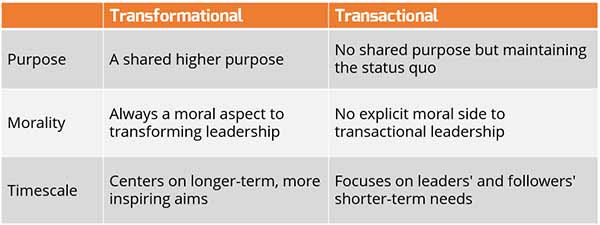We all find ourselves participating in some leadership training these days. Most, if not all, of these are corporate or human resource-driven based on a well-intentioned company desire to strengthen the organizational culture. This desire is driven by an underlying need to be a better company to achieve its desired success.
The issue arises when those charged with the execution of this objective fail to understand what drives leadership. All too often, the folks charged with the implementation of such endeavors lack leadership themselves and, as such, fall victim to the hype and buzzwords being peddled by unqualified external resources/consultants with good marketing but no leadership abilities themselves.
My goal with this article is to inform you on what it takes to achieve transformational leadership development.
I am often asked if leaders are born or made. A colleague of mine wrote a great book on this subject, Leadership Development in Balance, by Dr. Bruce Avolio.
The quick answer is both. Even those who are said to be born leaders need help in becoming true transformational and authentic leaders.
With all the talk of leadership these days, I wanted to provide some context to the discussion. I see everyone boosting their leadership training and certification on social media. There is discussion in the news and almost every aspect of our lives.
Sadly, all of the bluster is mostly buzzwords.
Organizations and individuals use fancy-sounding words to make it appear that they provide leadership.
So, let’s look at leadership.
Leadership is the most researched topic today. Everyone wants to understand it, but only some want to do the work associated with the understanding. One of the most widely misused buzzwords is transformational leadership.
If you need leadership help and the organization is touting transformational leadership, ask these simple questions. Where does the term come from? Who was the first person to coin this term? What are the four I’s of transformational leadership? If they cannot answer these simple questions, they are not the right organization to help you achieve it.
In his analysis of political leaders, the term transformational leadership was introduced in 1978 by Dr. James MacGregor Burns. His conclusions centered around the differences between management and leadership. Dr. Burns stated that transforming leadership is a practice where “leaders and followers help each other to advance to a higher level of morale and motivation.”
Burns associated the difficulty delineating between management and leadership and claimed that the dissimilarities are in behaviors and characteristics.
He further defined transformational leadership as charisma, like power, often used to explain leadership. Burns notes that the word transformational has become so abused as to “collapse under close analysis.”
He spoke of transformational leadership in four primary groups: heroic, intellectual, revolutionary, and reform leadership. Burns reasoned that transformational leaders develop followers as individuals and future leaders by allowing them to respond to their needs.
The terms transactional and transformational were first used by Burns, who studied political leaders like Roosevelt and Kennedy, to define these two different leadership styles in his 1978 book Leadership. Burns used the word ‘transforming’ rather than ‘transformational’.
Transformational leadership has four elements (also known as the “four I’s “): inspirational motivation, idealized influence, individual consideration, and intellectual stimulation. Each element will be examined to help leaders use this method on the shop floor.
Since the idea of transformational leadership was introduced by Dr. James Burns in his explanatory research on political leaders, its usage has increased in organizational psychology and management with additional changes by B.M Bass and J.B Avolio. They developed the full-range leadership model.
Transactional leadership is mainly grounded in control and processes and needs a strict management structure. On the other hand, transformational leadership centers on inspiring others to follow, and it entails a great degree of communication, coordination, and cooperation.
Next time your organization seeks outside assistance in developing transformative leadership skills, they must do their due diligence to see if the resource knows the subject or is just peddling stolen ideas with their unqualified twist.
Let’s look further into the body of knowledge around leadership. Leadership style was first studied in detail by Kurt Lewin in 1939. He was the first to identify the three leadership styles.
He labeled these styles as authoritarian (autocratic) leadership, participative (democratic) leadership, and delegative (laissez-faire) leadership. Dr. Burns used the terms transactional, transformational, and laissez-faire.
Dr. Burns worked alongside Kurt Lewin to advance the leadership style body of knowledge. Reimagining organizational change leadership requires revisiting the seminal work of these two giants. In the 20th century, the leading organizational development and change and leadership academics fundamentally changed their respective fields.
However, often misunderstood, misinterpreted, and even misrepresented, their exact advice was mainly ignored. In this article, we discuss why this is so. Despite decades of transformation and organizational change leadership discussion, leadership still needs to be solved. Working towards a substitute to the current convention, we reimagine organizational change leadership as a practical resulting process.
Countless political leaders show a transactional style. Mother Theresa was an example of someone who led using the transformational style.
The transformational leadership style consequently can overlap with other leadership philosophies.
- This involves purpose.
- This involves morality.
- This involves the timescale.

Transformational leaders apply a style of leadership that encourages changes in both the team members under them and the company. A mentor and visionary with an equivalent source of inspiration, these leaders promote a culture of innovation and change that provides a desired business outcome.
Transformational leaders do this by creating a distinctive culture within the organizations and teams that they lead.
It can be enticing to associate “transformational leadership” with a leader’s personality, thinking that strong, enthusiastic and/or passionate personalities drive transformational thinking, vision, and change within an organization.
While these may be the types of leaders who automatically come to mind, the characteristics of a transformational leader go much deeper and shouldn’t be thought of as innate personality traits or types. Developing a transformational leader is about building actions, behaviors, and strategies based on leadership theory.
Most admit that the concept of transformational leadership belongs to Burns, a political science and leadership researcher, who defined transformational leadership as “when one or more persons participate with others in a way that leaders and followers educate one another to greater heights of motivation and morality.”
In 1985, Bernard M. Bass, leadership researcher and professor at Binghamton University, expanded on Burns’ ideas to develop the Bass Transformational Leadership Theory, consisting of four main components of transformational leadership.
Intellectual Stimulation
Transformational leaders question the “this is the way we’ve always done things” mentality, challenging the status quo and defying the norms of even veteran leaders. They encourage this attitude in their employees. This means accentuating new experiences, new opportunities, and innovative ways of thinking.
By stressing the opportunities to grow and learn, rather than concentrating on the outcomes of the efforts, the transformational leader removes the “fear factor” from work, allowing employees to constantly learn and look for and act upon opportunities rather than playing it safe.
Individual Consideration
One of the key transformational leadership traits is the ability to communicate a sense of the larger culture to the individual, providing employees a feeling of ownership in company goals and individuality in the workplace.
Transformational leaders do not dictate ideas from their office and leave it to team members to carry them out. They are concerned with the professional development of team members and nurture positive relationships with them. This involves good communication skills, attending to the individual needs of the team members, mentoring them, and knowing each person’s unique contributions.
You can often spot a transformational leader by the trust, respect, and admiration others feel for them. Transformational leaders do not micromanage. They lead by communicating a clear vision and establishing a workplace where seasoned employees are trusted to make decisions in their work areas. All team members are encouraged to think creatively to find new solutions to longstanding problems.
Inspirational Motivation
Team members want leaders to impart a vision that is interesting and desirable. Transformational leaders do that by communicating a vision so well that followers internalize it and make the goal of attaining that vision their own. That starts with giving team members a strong sense of purpose and establishing high standards and expectations for achievement.
The motivation to achieve is not fear-based but inspired by the leader’s example. Transformational leaders set lofty standards and expectations for themselves and then model them for their team members and the company. Their actions instill the same desire they feel in their followers, whether for a project, a goal, or the larger company vision. Team members have a genuine sense of purpose and a “mission approach” to achieve their goals.
Idealized Influence
Showing it positively is the best way to impart inspirational motivation to team members. Transformational leaders serve as role models for team members in every way. That also includes demonstrating ethical and socially desirable behavior, upholding a dedication to work objectives, and exhibiting enthusiasm about company strategy.
The basis of this influence is trust and respect. Leaders who have developed idealized influence are trusted and respected by team members to make good decisions, not just “for the good of the company” but for the good of the team and themselves as individuals. With this trust, team members become followers who want to mimic their leaders and internalize their ideals.
Transformational Leadership Compared to Other Leadership Styles
These four “I’s” of transformational leadership laid the foundation for the philosophy and continue to help define it from other leadership styles. Let’s look at the relationship between transformational leadership and those leadership philosophies with a similar style and sound:
Transformational Leadership vs. Visionary Leadership
Some use the terms “visionary leadership” and “transformational leadership” interchangeably. A transformational leader may also be visionary when the situation calls for it. Visionary leaders look for new opportunities for the future of a company, the team, or even the product being made by the company.
Then, they aid others to conceptualize those visions and inspire them to find solutions. The difference between these leadership styles lies in a true transformational leader’s capability to encourage the development of new ideas. Even if the vision is not theirs, transformational leaders can make it a reality.
Transformational Leadership vs. Transactional Leadership
While visionary leadership may be very similar to transformational leadership, transactional and transformational leadership take opposite approaches, particularly motivation.
Transformational leadership plays the long game, concentrating on individual and company growth instead of short-term achievement. Transactional leaders create standards for success and reward or penalize team members based on their performance. This leadership style is mostly results-oriented and is more suitable when the goal is to complete specific tasks within a limited time frame.
Both leadership styles can be applied and combined to best aid a team’s function and achieve preferred goals. It is the job of the leader to recognize which leadership approach can best motivate team members to achieve those goals.
Following the development of transformational leadership, we have started with the seminal researcher Kurt Lewin. We traveled through Dr. Burns and Dr. Bass, and the next step was to Dr. Avolio. While working with Dr. Burns and Bass, Dr. Avolio advanced transformational leadership another step.
He identified that being transformational in leadership is not always a good thing. Let’s look at Adolf Hitler. He was very transformational in approach, but his leadership was not the desired.
Dr. Avolio added another measure of good transformational leadership with authentic leadership traits. To better understand the transformational leadership we desire, he measured a comprehensive range of leadership types, from passive leaders to leaders who give contingent rewards to leaders who transform followers into leaders. Transformational leaders can, however, be very effective without being authentic.
Authentic Leadership
The authentic leadership traits are:
Self-Awareness
To what level is the leader conscious of their limitations, strengths, how others see them, and how well the leader influences others?
Transparency
To what level does the leader reinforce openness with team members, allowing them to be forthcoming with their opinions, ideas, and questions?
Ethical/Moral
To what level does the leader set a lofty standard for moral and ethical conduct?
Balanced Processing
To what level does the leader ask for enough opinions and perspectives before making important decisions?
Combined, the full range and authentic leadership models offer a convenient approach to benchmarking and developing leaders.
I have added the final aspect of transformative leadership. As a student of Kurt Lewin, James Burns, Bernard Bass, and a colleague of Bruce Avolio, I have advanced their work to include ownership spirit. My original research and contribution to the leadership body of knowledge are documented in my doctoral dissertation and subsequent books.
Working with Dr. Dennis Deaton, we defined ownership as not waiting for other team members to act and wanting the outcome as much as an owner of the company would. It is being responsible for the outcomes of your actions, guaranteeing that they are of the uppermost quality and provided promptly.
Taking ownership shows team members that they can trust you to do the right thing. Those who take ownership are ready to take on whatever tasks come their way. They have strong problem-solving skills and foresee issues to prevent them, rather than waiting for things to go wrong and then scrambling to fix them or blaming someone else (victim thinking).
I hope this provides you with a roadmap through authentic transformational leadership, and now I want to leave you with the path to achieve it.
So, how do we wade through the sea of unqualified external resources to find those that can help our organization?
- Due diligence: stop listening to the hype and buzzwords. Do not fall for the marketing campaign. We must do the hard work of vetting those we plan to trust with this crucial aspect to our success. We cannot ever train our organization to be transformational. Training without development is a waste of time and money. Any effort to make a difference will require effort. You will need a leader who has led teams across many industries. Look for a well-rounded leader with the education, experience, and original research on leadership style that has contributed to the leadership body of knowledge. This will quickly eliminate well over 96% of all advertising they can help.
- Understand this is not a flavor-of-the-month effort. Leadership development takes time and investment. If the organization is unwilling to invest in developing their leaders with real work, save your money and your leaders’ time.
- Leadership is not developed in a conference room or classroom. It is not done by meeting a few hours once a month or reading a book. It is not done by assigning homework and adding to the list of things we are forcing our plant floor leaders to do.
- Leadership development must be executed on the shop floor where the work is. There is no one-size-fits-all approach or playbook like many external resources will advertise. There is no quick and easy fix; it requires hard work.
- The mentor you select must have led teams on many shop floors or in combat environments. Only with an understanding of leadership under extreme pressure at all hours of the day/night can they coach and mentor your team to the desired results.
- It must start with proven benchmarking methods. External resources employ many fancy tools to give the appearance of benchmarking, but none deliver actual results. Suppose we benchmark our team’s leadership style. In that case, a tool is the most used and accepted method to accomplish this—the multifactor and authentic leadership questionnaire, which provides not only a self-assessment by the leader but an assessment from all levels of the organization with respect to the leader. Employed by the skilled hands of a qualified leadership coach, we develop an individual leadership development plan to enhance desired traits and build needed traits.
- When we have done our work and identified the right external resource, we will partner with them to achieve the desired results, transformational leaders.








